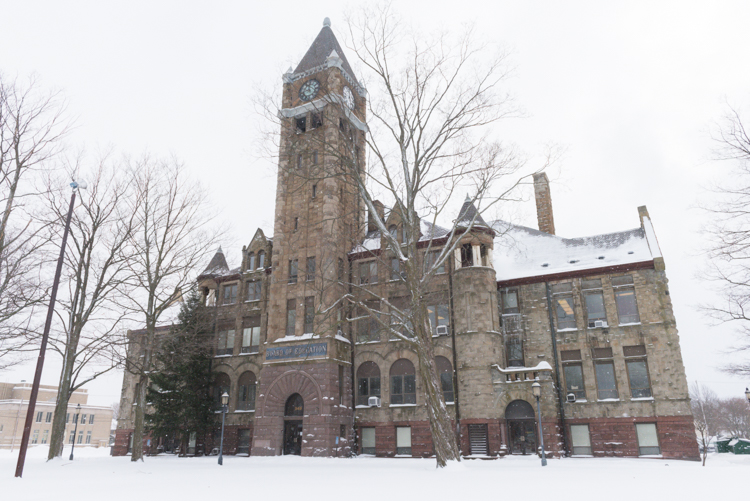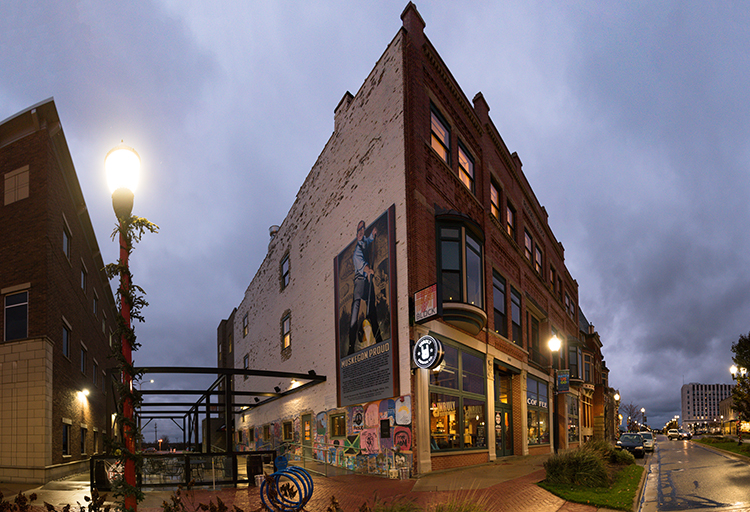With eyes on preservation, Muskegon tackles future of Hackley Administration Building
The Muskegon Public Schools will likely soon sell the Hackley Administration Building, and community leaders are determined to see it fall into hands that will preserve the historic structure.

Greg Borgman has a front-row seat to the pulse of Muskegon.
From his downtown home, he can watch the flurry of activity in Midtown—patrons immersing themselves in naan and records and burgers at places like Curry Kitchen and Third Coast Vinyl and Hamburger Mikey’s. He glimpses the bundled-up families exploring a winter-laden landscape: turn-of-the-century homes and apartment buildings and recently debuted shops topped with snow and sparkling with Christmas lights. Each day, he witnesses this city’s story unfolding: chapters filled with the lives of the artists, students, entrepreneurs, and so many others who call Muskegon home.
And Borgman, who has lived in Muskegon his entire life—save for the time he served in the U.S. Air Force—loves it all, but there is something that particularly sticks out, that has been a beloved companion to him for decades: the expanse of stone, brick, and wood that makes up the Hackley Administration Building at 349 Webster Avenue.
“I live less than a block from the administration building; if I look out my kitchen window, I can look right at the clock tower,” Borgman says of the tower perched atop the building built with money from Charles Hackley, the lumber baron and philanthropist who channeled most of his life’s fortune into Muskegon, resulting in the Hackley Library, Hackley Park, Hackley Art Gallery (now the Muskegon Museum of Art), and more. Opened in 1897 to replace a school that burned down, the structure that is now the administration building originally served as the Hackley Manual Training School—the first vocational high school in the entire state of Michigan.

“I’ve heard that clock tower since 1974, when my parents bought this house,” Borgman continues, referring to the tower’s bells that chime on the hour. “It’s a city and a public icon. It’s part of the gateway to our downtown. I really just can’t imagine not having that building there.”
The sentiment that the building is one that needs to be preserved, as well as kept accessible for the public, is being echoed across the city, particularly as the building’s current owner, the Muskegon Public Schools, will likely be looking to sell it at some point in the foreseeable future. For many in the city, from historic preservation advocates to museum and government leaders, the drive to preserve the Hackley Administration Building is about more than saving a beautiful, historic building—though it certainly is that. It’s about the collision of the city’s history, present, and future: a land of great loss and great expectations, a place where residents can shape their future by connecting themselves to the past.
“I dearly love this community, and I get frustrated with people who want to save buildings at the 11th hour,” says Borgman, who has long been a historic preservationist, going back to the days when he picketed the implosion of the iconic Occidental Hotel—which, for more than a century, was the centerpiece of Western Avenue and Third Street before being torn down to make way for the Muskegon Mall in April 1975.
“There are no plans to tear [the administration building] down, but I’m trying to heighten awareness. We screamed about the Chase Hackley Piano Factory being torn down, but we waited to the last minute,” Borgman says, referring to the recent demolition of the 127-year-old building on the Sappi paper mill property. “What do we do to make sure that doesn’t happen to the Hackley school building?”



The four-story, 50,562-square-foot Hackley Administration Building is one of the city’s historic buildings that was not knocked down to make way for the Muskegon Mall, an indoor shopping complex that spanned eight blocks covering 23 acres in the city’s downtown. Many of the city’s downtown historic structures, such as the Occidental Hotel and the Flatiron Building, were razed in order to build the Muskegon Mall—a venture that aimed to jumpstart the city’s struggling economy in the 1970s and which eventually closed in 2001 following the opening of the Lakes Mall in nearby Fruitport Township.
It’s a cavernous space that has been home to Hackley Manual Training School, Muskegon Community College, and the administrative offices for the Muskegon Public Schools. Located just across from Hackley Park, the Hackley Library, and the Torrent House, the building now holds about 20 employees. This translates to a space that is far underutilized, leaving the school district to take on repair, heating, and other costs for a building it really just no longer needs.

“The building is a historic building, and it needs a lot of work,” Muskegon Public Schools Superintendent Justin Jennings says. “We can’t do it justice with the budget we have, and I don’t feel comfortable investing a lot of money in it when our kids need newer buildings.”
Jennings notes the district has looked at a number of different possibilities for the building.
“We’ve had the city or county consider moving in; we’ve had someone offer to buy it and create a boutique hotel or condos,” the superintendent says, stressing that “tearing down the building has never been a topic of conversation.”
Currently, there are a number of prospects on the table for the building, including Muskegon City Hall or the Lakeshore Museum Center moving in there.
“It would probably be a two- to five-year plan; it will take time for someone to move in and renovate it,” Jennings says.

Muskegon City Manager Frank Peterson says there are preliminary talks regarding the city and/or county potentially moving into the administrative building.
“We’ve talked about that concept; whether or not we can get to that end is another question,” Peterson says. “The best way to save that building and preserve it for the community is to see somebody like the city or county own it.”
The city manager notes that while it’s feasible the city or county could lease it to an entity like the Lakeshore Museum Center, it would be more likely that City Hall itself would move into the space.
“At the same time, we have this big City Hall building right now that taxpayers paid for, so it’s something that would have to be figured out,” Peterson says.
“Collectively, the public agencies around Muskegon and Muskegon County—the city, the county, the schools—we’re not going to let that building be lost,” he continues.


The Lakeshore Museum too would fit well in the space, Jennings notes.
“The museum is a great idea because when you go onto each floor, the middle is open with rooms around it; it could be renovated in a way where you could do displays in there,” the superintendent says.
Currently, the Lakeshore Museum Center houses its exhibits telling the story of 400 million years of Michigan history in a former YWCA building at 430 W. Clay Ave. in downtown Muskegon. The museum also runs multiple other historic sites and buildings, including the Hackley & Hume Historic Site, the Fire Barn Museum, the Scolnik House of the Depression Era, and Michigan’s Heritage Park at Hilt’s Landing in Whitehall.
For much of the three years that Annoesjka Soler has been the executive director of the Lakeshore Museum, she has worked on plans to move the institution into the Hackley Administrative Building—a venue that would allow the museum to significantly increase its offerings.

“We could do so much more programming,” Soler says. “It’s across from Hackley Park, the public’s go-to downtown place; it would become part of that downtown mall tied to Muskegon Community College, the library, the art museum. We could make it a pedestrian area that would have all the culture right there.”
Plus, she notes, the move would likely inspire a significant jump in the number of visitors to the Lakeshore Museum. “This building is very nondescript,” Soler says, referring to the museum’s current home on Clay Avenue. “The administrative building, people always want to get in and see it. We were envisioning we’d move our programming over there and our exhibits over there. It would give us the chance to update our exhibits. And the third floor is a giant auditorium; we could keep that as programming space and make it rentable space for the community.”

At this point, there are no definitive plans for the Lakeshore Museum to move into the Hackley building, largely because of a prohibitive price tag. The museum conducted a feasibility study to see what it would need financially in order to move into the administrative space, and that study resulted in estimates hovering around $25 million, which would include the cost of a 20,000-square-foot addition. If the addition wasn’t done, the price would drop to $15 million, a number that, Soler explains, could be broken down into something like $5 million from local donors, $5 million through a millage, and $5 million through state grants.
While it may still seem like a long shot for the museum, it’s certainly not off the table—and Soler is hoping, with the museum’s current focus on enhanced programming and a shift to more hands-on programming that’s a draw for families and children, the public will support a financial campaign to get the museum into the Hackley building. For example, this spring the museum is hosting an exhibit from California called “The Secrets of Bees,” which will have a wide-ranging focus on the role bees play in our world, from the environment to entrepreneurship. As part of this exhibit, the museum will feature everything from honey businesses in the area to mead tasting.
Whether the Hackley Administration Building becomes home to the Lakeshore Museum, City Hall, or something else, historic preservation advocates say it’s crucial for the community to become engaged in discussions about the facility’s future now. To this end, Borgman has launched a committee of concerned citizens to rally around the building’s preservation and work on its future use (the public is welcome to join the committee, which they can do by connecting with Borgman on Facebook).

Terry MacAllister, who grew up in the Nims neighborhood and has long led the charge for historic preservation in the city, is urging younger residents to get involved in this process.
“It needs to be younger people who need to step up, and us old folks need to step back and mentor because the decisions we might make may not be what the younger people envision for the future,” MacAllister says.
And, MacAllister notes, the younger generation is becoming increasingly active in both preservation and the downtown, from opening places like Pigeon Hill Brewing Company and Unruly Brewing (both of which are in historic buildings themselves) to renovating older homes—translating to a population that is focused on not only growing their city, but on doing so by finding ways to reuse older buildings. This mirrors a push nationwide, by those young and old, to preserve and reuse historical buildings, and advocates stress this push for preservation results not only in retaining the stories of a community, but in financially and socially strengthening neighborhoods and cities.
“[Historic preservation] has proven to be an effective tool for a wide range of public goals including small business incubation, affordable housing, sustainable development, neighborhood stabilization, center city revitalization, job creation, promotion of the arts and culture, small town renewal, heritage tourism, economic development, and others,” PlaceEconomics, a firm that has studied the impact of historic preservation for more than 30 years, writes in a 2013 report.
In Muskegon, for example, a focus on preservation has translated to a stronger downtown economy, with historic structures like the Frauenthal Center, the old Shaw Walker factory building (now the Watermark Center, a million-square-foot mixed-use development that includes apartments and The Coffee Factory), the Russell Block building (where Unruly Brewing, Rebel Pies, and Drip Drop Drink are now located), and the old Savings and Loan Bank that is now 18th Amendment playing starring roles in reshaping the local economy.

“We see more younger people coming in,” says MacAllister, who bought his first home in downtown Muskegon in 1974 and has since championed historic preservation while serving on the City Council, the Planning Commission, and numerous other organizations and committees. “We’re getting these kids to come in and see the importance of the history of their houses and, in turn, the architecture. That’s what I find so exciting.”
Like Borgman, and so many others throughout the city, MacAllister has a deep appreciation for the Hackley Administration Building and the role it has played, and could continue to play, in the community. No matter who moves into the building, the space will, and must, remain an integral part of Muskegon’s downtown fabric, he emphasizes.
“I’ve always said the heart of Muskegon is at Western and Third—the Frauenthal, the hotel, the Chamber, but the soul is Hackley Park and everything around Hackley Park,” he says. “That building, the Hackley Administration Building, in and of itself is the jewel in the crown.”
“It’s not in danger of being torn down this week, but that doesn’t mean it won’t be,” MacAllister continues. “It’s better to be proactive than to react when the wrecking ball is there.”

Adam Winters, an avid historian and local machinist who in 2011 repaired the Hackley Administration Building’s clock tower after its bell stopped ringing, agrees with his fellow preservationists, stressing the importance of preserving the structure and keeping it available to the public.
“If we were to take down the Hackley building tomorrow, we could never get it back,” says Winters, who himself has played an integral role in preserving the city’s history through his work at the Muskegon Heritage Museum, including getting the museum’s 1893 Corliss Valve Steam Engine into working condition.
“We would never get anything close to it,” Winters continues, adding that he believes “the [Lakeshore] Museum would be an awesome use for it.
“First off, the building is historic, and a museum needs to be in an historic building,” Winters says. “Any alternative uses would be a disgrace to the building. If you turned it into an office building, you’d totally destroy the interior integrity, unless you want an office the size of a school room. They’d go in and build cubicles, and then you’ve destroyed it.”
Creating a space that anyone can regularly use is crucial for a building like the Hackley school site, which Winters and other preservationists stress was originally built for the public.
“When you walk into that place, through the big doors, and see the woodwork, there’s a sense of awe,” Winters says.
This story is part of Rapid Growth’s “On the Ground-Muskegon Lakeshore” series, which aims to amplify the voices of the community members who make up Muskegon’s waterfront neighborhoods. Over the next three months, our journalists will be embedded in the city’s lakefront communities in order to dive deeper into topics important to residents, business owners and other members of the community. To reach the editor of this series, Anna Gustafson, please email her at AKGustaf@gmail.com, or connect with her on Facebook.
Support for this series is provided by Downtown Muskegon Now, the Muskegon Business Improvement District, the Muskegon Lakeshore Chamber of Commerce, the Michigan Economic Development Corporation, Pure Muskegon, Watch Muskegon, and the Community Foundation for Muskegon County.
Photography by Jenna Swartz. To connect with Jenna, visit her website and Facebook page.









